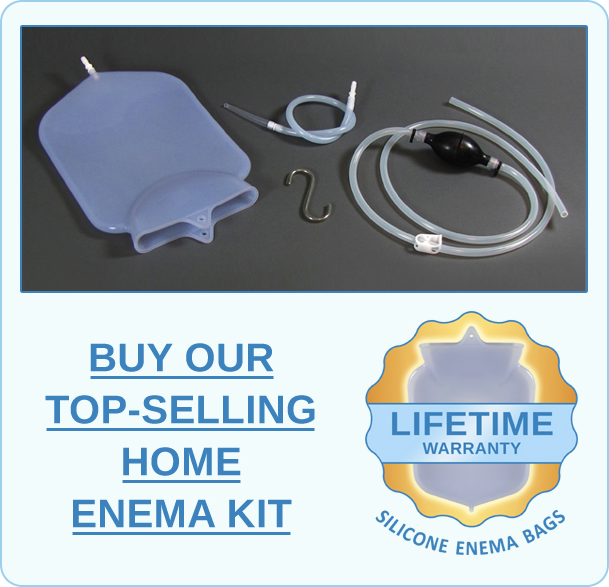Probiotic Enemas
Overview, Best Probiotics for Enemas, and Step-By-Step Instructions
What Is a Probiotic?
Probiotics are living microorganisms — healthy bacteria — that have been shown to provide beneficial health effects to the host by replenishing natural gastrointestinal flora.Having a healthy level of diverse probiotics in your gut means a healthier gut microbiome, which is important for the overall health of your body, the strength of your immune system, and the functioning of your digestive system.
According to research published in 2013, probiotics also help to improve cholesterol levels and treat numerous diseases such as Crohn's, ulcerative colitis, and IBS.
Probiotics are generally consumed orally as supplements, but recently more and more people are becoming interested in introducing probiotics directly into the colon via implants (retention enemas) or suppositories.
Two Basic Strains: Lactobacillus versus Bifidobacterium
There are two main strains of probiotics: bifidobacterium and lactobacillus. Some probiotic supplements are primarily one strain or the other, while others combine multiple strains.Lactobacillus is one of the more common strains because it is more viable in gastric conditions than bifidobacterium due to its greater resistance to gastric acid. Up to 60% of probiotic bacteria can be killed by your stomach acid prior to reaching your intestine, which is one reason many people choose to use probiotic enemas.
There have been many scientific studies done on these two probiotic strains, and it is widely acknowledged that both strains have the ability to prevent and treat various health issues.
However, studies have also shown that some strains may be better for treating different health issues than others. For example, while Lactobacilli have been found to be effective for treating antibiotic-associated issues like diarrhea, bifidobacteria may be better for treating conditions like IBS and chronic constipation, and some reviews have found that it is the more effective of the two overall.
Most research just finds that probiotics overall are beneficial for health; more research is needed to fully understand the difference between the strains.
Are Probiotic Implants (Retention Enemas) Better Than Taking Capsules Orally?
In certain cases, delivering probiotics directly to the colon can be more effective than oral ingestion.While it's true that some probiotics may be killed in digestion, most probiotic manufacturers have created delivery systems that are designed to keep the probiotics alive through the stomach acid and digestive process, until they reach the intestinal tract.
Both methods of taking probiotics are beneficial, but if you have the time and ability to regularly take enemas, if you are suffering from chronic constipation or IBS, or if taking oral probiotics makes you feel sick, a probiotic implant may be a good option for you.
If you don't have much time and/or are not suffering from a gut disease and just want to improve the health of your gut microbiome, eating more
Best Probiotic Strain for Colon Implants
If you would like to try a probiotic implant (retention enema) at home, I have two different probiotic recommendations:- Bifidonate — Containing Bifidobacterium bifidum Malyoth (2 billion CFU per ½ teaspoon), this probiotic produces B vitamins necessary for the digestive process, assists in the absorption of vitamins and minerals, inhibits harmful bacteria, supports healthy liver function, and helps to promote regularity. I recommend this over other strains such as lactobacillus because of research indicating that bifidobacteria are more beneficial for your health than lactobacilli. Additionally, lactobacillus' ability to survive stomach acid is not necessary if you are taking a probiotic via colon implant.

- Ortho Biotic — I recommend Ortho Biotic for both colon implants and oral ingestion. It does not need to be refrigerated and contains seven different probiotic strains which combine to support microflora balance, bowel regularity, and optimal immune function.
▶︎ How To Use Probiotics in Colon Implants
Suppositories and Probiotics
If you'd prefer that your probiotic is directly received by the colon, another option for administration is adding probiotics to suppositories. To do this, add the contents of 1 probiotic capsule, or ½ teaspoon of Bifidonate, to coconut oil, mix together, and freeze to make a suppository.Certain essential oils provide health benefits for your colon and microbiome similar to probiotics. Optimal Health Network's Anti-Inflammatory and Flora Booster Essential Oil Blend and Colon Cleanse Essential Oil Blend are designed to support the healthy bacteria in your microbiome, reduce inflammation, strengthen the immune system, and act as a prebiotic.
Similar to taking probiotics, using targeted essential oils in suppositories or as part of a home enema regimen can help you to overcome many health challenges such as Candida overgrowth, ulcerative colitis, and IBS.
▶︎ How To Make Coconut Oil Suppositories
A Side Note: Probiotics in Food
While probiotic supplements are a great way to improve your gut health, eating healthy foods that contain probiotics is also beneficial for your overall health. Such foods include kombucha, sauerkraut, kefir, kimchi, miso, andHow To Do a Probiotic Implant (Retention Enema)
- Take two cleansing enemas before taking a probiotic implant. It's best to do the first two enemas outlined in my recommended home enema series:
- First Enema: Use Frankincense and Myrrh Goat Milk Soap. Soak the bar of soap in filtered water for 20-60 seconds to make a milky solution. Add to 1-4 quarts of filtered water and slowly take in this enema. Once fully taken in, you can release the enema on the toilet. There is no need to hold.
- Second Enema: Use Colon Cleanse Essential Oil Blend mixed with Celtic Sea Salt. In a small bowl, add about 1 teaspoon of Celtic Sea Salt per quart of water. Mix 3-5 drops of the oil blend per quart of water into the salt. Add the salt and oil mixture to your enema bag and water once mixed.
- After doing the first two enemas, empty 2-4 probiotic capsules of your choice. I recommend using Ortho Biotic. If you're using Ortho Biotic Powder, we recommend 2 scoops. If you're using Bifidonate, add 1 teaspoon of this probiotic to ½ to 2 cups of filtered water or aloe vera juice. Mix with water or aloe vera juice until fully dissolved. Add this solution to your enema bag, bucket, or implant syringe.
- Take the colon implant into your body slowly, as you would an enema. By allowing 5-10 minutes to take in the entire volume of the implant, and by using a colon tube to deliver the solution deeper into the colon, your body will have an easier time holding the implant.
- Retain the solution for as long as you are easily able to/have time to (ideally at least 15 minutes). If you aren’t able to hold the enema for the full 15 minutes, that's OK. Listen to your body and empty if you need to.
- Empty the solution on the toilet.
▶︎ How To Take an Enema at Home
You can do a probiotic implant as frequently as you’d like, as long as you find that it's making you feel better and not worse. Listen to your body throughout the process, and remember to hydrate well before, during, and after enemas!
SUMMARY
Having a good amount of diverse strains of probiotics in your gut microbiome strengthens your immune system, helps prevent disease, and is important for your overall health. There are several good options for delivering more probiotics to your gut: taking a daily probiotic orally, eating more probiotic-rich foods, and taking regular probiotic implants and/or suppositories. All of these options can be beneficial. It's important to choose the option(s) that work best for you, and make your body feel its best!Labels: colon implant, enema, essential oils, prebiotic, probiotics, suppository









0 Comments:
Post a Comment
<< Home